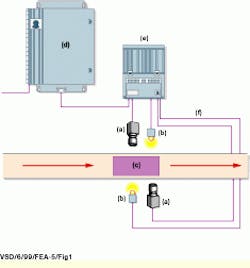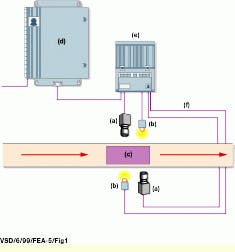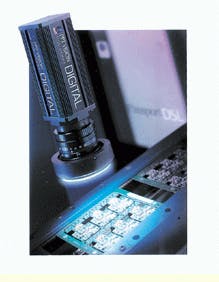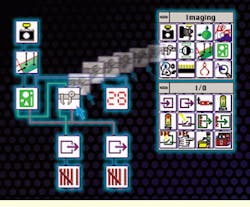Digital machine-vision pharmaceutical inspection purges signal noise
Digital machine-vision pharmaceutical inspection purges signal noise
Lawrence J. Curran
Contributing Editor
Electrical noise runs rampant in manufacturing plants. Product inspection with an analog machine-vision system on a factory floor in the presence of noisy motors and solenoids can cause image degradation. That problem existed for a Nebraska-based manufacturer of medical
devices and pharmaceutical supplies that set out to overcome signal-noise degradation on a production line established to perform a 100% imaging inspection of hypodermic syringes. The platform solution came in the form of an all-digital machine-vision system that is essentially a computer network.
The Kendall Co. (Norfolk, NE; previously Sherwood Medical) determined that it needed automated machine-vision inspection on its hypodermic-syringe production lines. The company, a division of Tyco International Ltd. (Exeter, NH), could no longer rely on human inspectors to perform 100% inspection because the production line moves too fast, often at 2000 to 3000 parts per minute
Bill Gustafsson, Kendall production engineering manager, says the company evaluated a number of major manufacturers before selecting a systems integrator "and found that PPT Vision (Minneapolis, MN) offered the products we could work with." The Kendall Co. now has 12 machine-vision systems in its plant supplied by PPT Vision Inc. (Eden Prairie, MN). The latest system, which is working on the line assembling hypodermic syringes, is essentially a two-camera Passport digital serial link (DSL) system, for which a patent is pending (see Fig. 1).
Digital data network
PPT Vision describes the DSL system as bringing digital computer networking to machine vision. The all-digital system delivers high-speed, noise-free bi-directional image acquisition and data transfers to 330 Mbits/s. Gustafsson says the two cameras, which PPT Vision designed and manufactures, are positioned at different locations to capture different-angle images as the syringes move past the inspection station. "We inspect for the presence of required components and do some dimensional checking," Gustafsson reports.
"It`s important to have 100% inspection to ensure product quality and to maintain tight control over the manufacturing process," he says. Use of the Passport DSL system contributes to that control, according to Gustafsson. "We use the system to log defects by category, which allows us to take corrective action early if something is amiss," he adds.
The medical-device/pharmaceutical firm has been a PPT Vision customer for at least six years, according to Chuck Bourn, PPT Vision director of marketing communications. The system in use at Kendall includes CCD cameras, multiple processors, hubs, monitors, and a twisted-pair network, and all these digital components were designed and built by PPT Vision.
Bourn says digital machine-vision systems overcome several limitations of analog systems; they provide a noise-free signal that can be transmitted faster and over greater distances without degradation. In the Passport DSL system, that capability translates into an image and data rate of 330 Mbit/s over distances as far as 200 ft from the image processor to the hub, hub to hub, and hub to camera with no image degradation or signal loss.
Nulling the noise
Elimination of noise is a major DSL contribution, Bourn says. Video noise causes image-to-image variations in machine-vision systems that use analog cameras and transmission techniques. The noise randomly alters the values of individual pixels of an analog image. It can occur anywhere in analog cameras, in the cables connecting them, in the cable connectors, and in the analog-to-digital (A/D) converters of the frame grabbers.
Video noise is especially prevalent in factories where high-voltage pulses, welding arcs, and even cellular phones and beepers can alter individual pixels in analog images traveling through cables. The DSL system rules out this noise.
The integrated DSL network forms a complete, ruggedized, industrial machine-vision system. Bourn says this network also allows a user to distribute imaging and input/output (I/O) tasks where they`re needed most--on the network. This approach prevents bottlenecks at a central machine-vision processor and enables system expansion, as desired by a user, without adding central processors.
To take full advantage of the digital architecture, PPT Vision has incorporated its PPT-designed digital camera, the DSL6000, into the system (see Fig. 2). The camera uses an Eastman Kodak (Rochester, NY) CCD sensor with a resolution of 640 ¥ 480 pixels. Bourn points out that PPT Vision couldn`t find a suitable camera on the market that met the company`s requirements for use in a digital system, "so we designed and built it. The camera had to be small and rugged for industrial applications."
The camera also incorporates a 10-bit A/D converter from Harris Semiconductors (Palm Bay, FL) for greater resolution in digitizing images. Bourn says most analog cameras rely on 8-bit A/D converters that reside on the frame-grabber board, which can compromise gray-scale resolution. One or two error bits are always recorded, which then must be discarded. "But with the ability to digitize a full 10 bits, the DSL6000 camera delivers 8 full bits of reliable image data, which yields a true 256 levels of gray," Bourn adds. In contrast, 8-bit frame grabbers deliver perhaps seven or six true bits, and 128 gray levels, at most.
Having a built-in A/D converter also means that digitizing takes place in the camera, eliminating the need for a separate frame grabber, which can also slow image processing and limit the number of cameras one processor can control, according to Bourn. The presence of image memory on each hub takes the place of memory normally found on the frame-grabber board and allows for true asynchronous image capture from as many as 16 cameras.
Processor passport
The system incorporates a DSP-based image processor and a digital host processor (DHP), which are combined with the DSL software and digital camera. The chip on the dedicated image-processor board is a Texas Instruments Inc. (TI; Dallas, TX) DSP. There`s also a TI DSP on the DHP board, which is an I/O board that functions as the system`s traffic controller.
This host processor routes and reassembles the digital packets of data, images, and triggers moving on the network to produce clear images for accurate processing. In the background, a Pentium-based PC motherboard runs Microsoft Windows 95 and drives the system interface to the monitor.
The hubs bring all the I/O facilities close to where they are needed. They also control all local triggering and interrupt functions, have sufficient on-board memory for all local cameras so they can store images for true asynchronous operation, and provide a convenient node for expanding the network. Further, they supply all the power needed for local cameras, I/Os, and a DSL up-link, if used.
During Kendall`s factory operation, the syringes are first loaded into an assembly rack and are then stepped past the system`s first camera in an indexing sequence. A sensor triggers a strobe light, allowing the camera to capture images of the syringes, which are sent over the DSL system to the image processor. Next, the parts move past the second camera in a wheeled fixture at a constant high rate of speed, which can be 2000 to 3000 parts per minute. Images of different part sections are captured to ensure that all components of the syringe are installed. Both cameras work in horizontal positions, and both use LED backlighting provided by PPT Vision, Gustafsson says.
In the Kendall operation, the image-processing board executes algorithms that reside in at least two software tools from PPT Vision: an optical-character-verification (OCV) tool and a sub-pixel line-gauge tool (see Fig. 3). In addition, two hardware accelerator cards that plug into the DHP are available for the DSL systems. One card provides a pattern-finding algorithm called FlashFind. The second card serves as a blob accelerator, which can be used with the OCV tool, the line gauge, and other tools for high-speed measurements and inspection.
Gustafsson says, "The latest system is much faster and more flexible than the older [analog] machines. We can readily reconfigure it any way we want. The older systems are limited in both processing speed and in the number of cameras--four--they can accommodate."
He points out that the Passport DSL system hubs enhance flexibility by facilitating expansion: "If I want to add a camera and a light source, I just modify the software a bit and I have it."
FIGURE 1. The all-digital PPT Vision Passport DSL system in use at The Kendall Co. comprises two digital cameras (a) with LED backlighting (b) that capture different views of the hypodermic syringe trays (c) as they pass the production-line inspection station at 2000 to 3000 per minute. The processor unit (d) houses the digital-signal-processing (DSP) board, the DSP-based digital host processor, and the Pentium-processor motherboard. The hub enclosure (e) controls all local triggering and interrupt functions over twisted-pair wire (f) and contains sufficient memory storage for the cameras to ensure true synchronous operation.
FIGURE 2. The PPT Vision DSL-6000 digital camera houses a 10-bit analog-to-digital (A/D) converter that delivers higher gray-scale resolution than that provided by analog cameras. This approach eliminates the need for a frame grabber. Analog types usually rely on 8-bit A/Ds that reside on a frame-grabber board.
FIGURE 3. The DSL system graphical user interface uses drag-and-drop icons to represent the programming tools available for image processing. The illustration shows activation of the line-gauge algorithm, which can make multiple measurements, to subpixel accuracy, between selected points on an image.
Company Information
Eastman Kodak Co.
Rochester, NY 14650
(716) 722-4385
Fax: (716) 477-4947
Web: www.kodak.com/go/ccd
Harris Semiconductors
Palm Bay, FL 32902
(407) 724-7000
Fax: (407) 724-3131
Web: www.semi.harris.com
(The) Kendall Co.
Norfolk, NE 68702
(402) 371-9010
Fax: (402) 371-0117
E-mail: [email protected]
PPT Vision Inc.
Eden Prairie, MN 55344
(612) 996-9500
Fax: (612) 996-9501
Web: www.pptvision.com
Texas Instruments Inc.
Denver, CO 80217
(800) 477-8924
Web: www.ti.com
Tyco International Ltd.
Exeter, NH 03833
(603) 778-9700
Fax: (603) 778-7330
Web: www.tycoint.com



